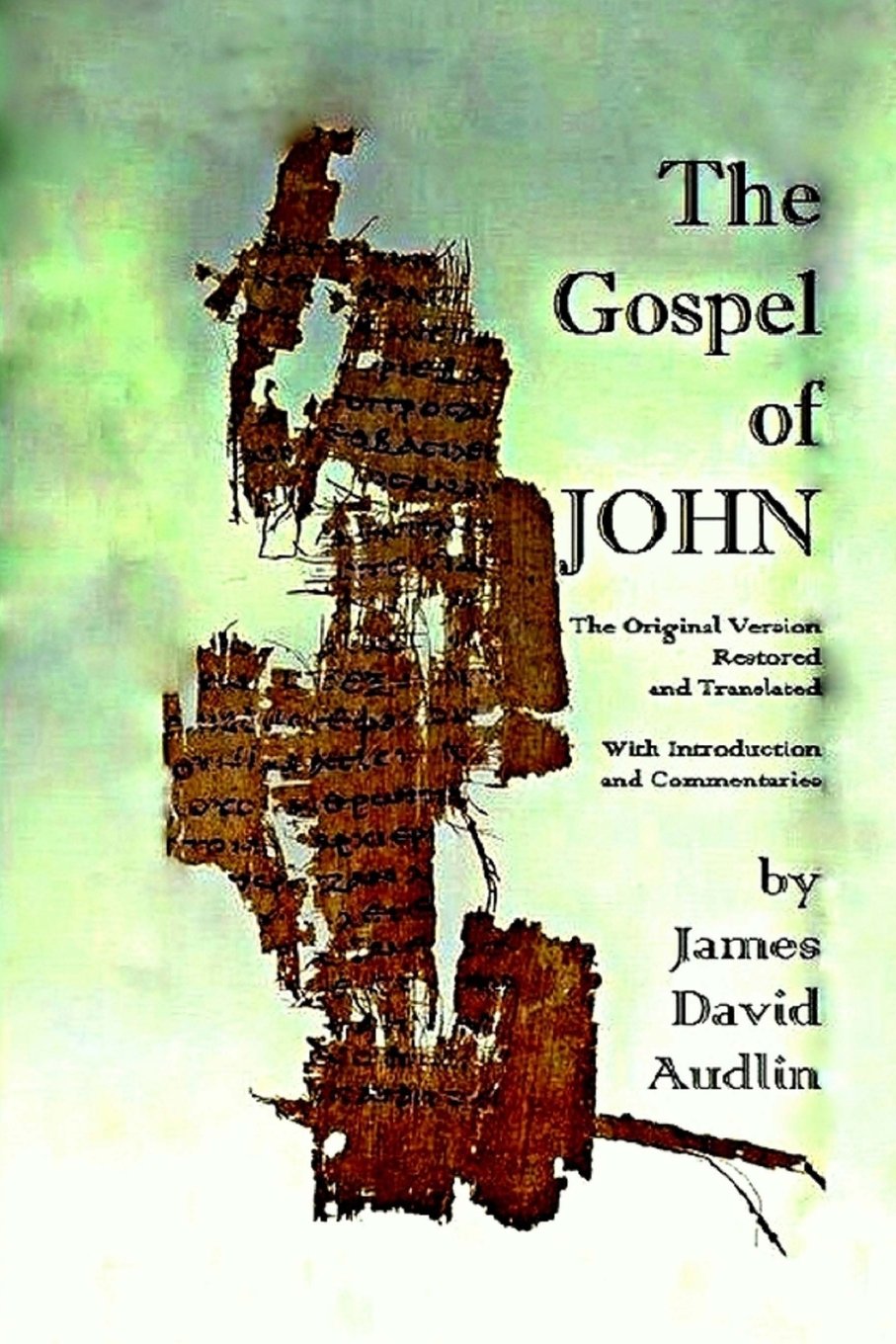Book review: The Gospel of John
by James David Audlin
★★★★★
Controversial research, good writing, and an approach to the Jesus story as a puzzle to be solved makes for an enthralling read. There’s so much insightful commentary in this one that I couldn’t begin to measure where I agree versus where I disagree, but that’s hardly the way I evaluate books anyway. I want something that makes me think, and this one does.
My one complaint with the book is that it’s a bit slow getting started. The intro, which serves mostly to present credentials, was wordy. What you need to know is that Audlin presents his own translation of John’s Gospel, with liberal commentary, and in so doing makes an effort to restore it as close as possible to its original format and flavor. Late glosses and interpolations are removed, sections are repositioned where they appear to be out of order, words or phrases are restored where they appear missing, and certain current-day conventions and phraseology that distort the message have been swept away. One drawback to this reordering, of course, is that it makes for an awkward reference digest; while detailed by chapter-and-verse, the text is all out of order.
Audlin shares with me a belief that there was an early composition of John’s Gospel, decades before its final form. He finds the most likely scenario of how this “early” John’s Gospel came to be as such: Lazarus, the man whom Jesus restores to life, is the Beloved Disciple and the main voice behind the Gospel. The Gospel is a corroboration between Lazarus and John Mark, the author of all five of the Johannine documents. Lazarus dictated the story of Jesus to John Mark, but the final project was derailed, probably by the war. [Correction provided by the author: The amanuensis was not John Mark, but John the Presbyter.] It was later collected and organized by a redactor, and subjected to further changes by other anonymous contributors. It is the original form that Audlin hopes to present in his translation … not merely the words they left behind, but the intended composition.
Adding to the complexity of this task is Audlin’s contention that certain original themes were downplayed during the redaction process, sometimes by even removing text that John Mark had written. For example, Audlin concludes that the marriage in Cana was of Jesus and Mary Magdalene, but anything suggesting that Jesus was the bridegroom in the story was extracted by the redactor.
Audlin puts a great deal of trust in the Beloved Disciple, as the eyewitness, in presenting historical truth. This lets Audlin interpret much of the text (that which he attributes to the Beloved Disciple) with brutal precision. When John’s Gospel tells how the almighty Roman Empire bowed in obeisance to a lowly Jewish rabbi (Jesus, at the arrest site), it really happened as written! This refreshing trust is not naivete on Audlin’s part, since he hardly reads the Bible as inspired. He certainly has no such trust in the writer of Matthew’s Gospel!
Many of Audlin’s conclusions are based on Aramaic idioms and the Peshitta (the Syriac, an eastern Aramaic New Testament of disputed authorship and origin, which contained most of the canon of today’s Bible), and I must confess, of this analysis I can contribute nothing. I am thus unable to evaluate the strength or weaknesses of Audlin’s linguistic arguments, and they do form much of the foundation of his scholarship.
One of the idiosyncrasies of Audlin’s thesis (again, drawing heavily on the Peshitta) is the collapse of many Bible characters into one big happy family (well, maybe not so happy). Among these family ties we can count Jesus, Mary Magdalene (his wife), Martha, Simon the Leper, Joseph of Arimathea, the Beloved Disciple, Peter, John Mark, John the Baptist, John the Presbyter, Lazarus, Thomas, the Samaritan woman at the well, Barabbas, Judas, and surely a few more I didn’t catch. Some of these names collapse further into a single person; Lazarus, for example, is also Barabbas and the Beloved Disciple.
So, yes, Audlin’s work is surprising, edgy, opinionated, and yet deeply researched. Small wonder that he grows a bit compulsive in detailing his credentials! This project was clearly a labor of love and his appreciation shines for the original beauty of the Gospel, even as his distaste for the clumsy insertions and distractions of the redactor also shows through. He and I share both feelings, and in fact, we share many other unconventional conclusions, and listing a few will give a feel for the flavor of the writing:
1. The Gospel is not at all chronological, and really indicates closer to a one-year ministry for Jesus rather than three years, though Audlin and I disagree on the reason for the jumbled format.
2. We agree that conservative Christianity has mangled the meaning of “eternal life” in this Gospel; Audlin has opted to simply revert to John’s original word, aeon. Jesus promises “aeonic life.” That’s probably best, and in one of many essays at the end of the book, Audlin carefully attempts to put the original flavor back in Jesus’ promise.
3. We agree that the text probably says Jesus did not walk on water (though other Gospels do).
4. We agree that Jesus, himself, did not consider himself any more “one with God” than the rest of humanity.
On the other hand, we disagree pretty strongly on other topics! I encourage both an open mind and a discerning eye, and plenty of time to wrangle with the ideas.

Book review: The Gay Disciple
by John Henson
★★★★★
I enjoyed this one! This is fiction, building upon the story of several notable but sketchy characters in the New Testament. Henson modernizes the names and nicknames of his characters (Jim for James, Rocky for Peter), which added to the enjoyment for me. I found myself embracing the puzzle of figuring out who the characters were in the Bible.
All characters tell their story in first person, beginning with Lazarus, the man whom Jesus raised from the tomb. Lazarus is presumed to be the “Beloved Disciple” of John’s Gospel, a conclusion Henson considers “undoubtedly” true, and that the Gospel writer “could hardly have made any more clear.” Henson shares this opinion with other recent scholars, including Ben Witherington (see Revelation, The New Cambridge Bible Commentary) and a fascinating book by James David Audlin that I’ll be reviewing soon. In my own book about John’s Gospel, I also tie Lazarus to the Beloved Disciple, so I am sympathetic to the arguments.
Henson goes a step further with Lazarus. Who is this grown man, greatly loved by Jesus, living with his two sisters on a large estate? Speculation helps fill any void, so Henson makes him gay, and Henson’s lessons through his semi-fictional characters are not exactly subtle. Jesus and Lazarus soon embrace, a bit more intimately than one might expect. But is this inappropriate topic matter, or uncomfortable for Christian readers? The Beloved Disciple, you recall, reclines on the breast of Jesus at the Last Supper. Says Lazarus, as he bemoans not being able to tell his story, “Maybe for my lifetime, maybe for many hundreds or even thousands of years, my story would be taboo, until that day came when Christians would no longer be afraid of love. I wanted to tug at John’s sleeve, ‘Tell them how beautiful [Jesus] looked! Tell them about his glistening hair, his twinkling eyes and his hairy chest!'”
As it turns out, nowhere in the book is Jesus portrayed as gay; only that Jesus feels no discomfort at sharing a physical closeness with Lazarus, the same as he does with any disciple, male or female. Jesus’ favoritism toward Lazarus exists (at least in Lazarus’s mind), but is actively tempered.
From Lazarus, we move on to several more characters, and I won’t spoil your enjoyment by listing them. I’ll just say the book got better and better for me as it went. If there is a common theme surrounding Henson’s choice of characters, it’s that each feels marginalized or unsettled before meeting Jesus. This is not an evangelical book, merely a book about the atmosphere Jesus brought to all he came in contact with. It certainly doesn’t solve life’s problems or explain all the mysteries of what happened in the first century. But at the same time, this book won’t be quickly forgotten.













 354 Circles
354 Circles
 603 Goodreads Friends & Fans
603 Goodreads Friends & Fans

 Hello! I'm an author, historical Jesus scholar, book reviewer, and liberal Christian, which means I appreciate and attempt to exercise the humanitarian teachings of Jesus without getting hung up on any particular supernatural or religious beliefs.
The Bible is a magnificent book that has inspired and spiritually fed generations for thousands of years, and each new century seems to bring a deeper understanding of life’s purpose. This is true of not only Christianity; through the years, our age-old religions are slowly transforming from superstitious rituals into humanitarian philosophies. In short, we are growing up, and I am thrilled to be riding the wave.
I avidly read all thought-provoking religion titles. New authors: I'd love to read and review your book!
Hello! I'm an author, historical Jesus scholar, book reviewer, and liberal Christian, which means I appreciate and attempt to exercise the humanitarian teachings of Jesus without getting hung up on any particular supernatural or religious beliefs.
The Bible is a magnificent book that has inspired and spiritually fed generations for thousands of years, and each new century seems to bring a deeper understanding of life’s purpose. This is true of not only Christianity; through the years, our age-old religions are slowly transforming from superstitious rituals into humanitarian philosophies. In short, we are growing up, and I am thrilled to be riding the wave.
I avidly read all thought-provoking religion titles. New authors: I'd love to read and review your book!
 Hi! While Lee writes the articles and reviews the books, I edit, organize, and maintain the blog. The views expressed here are Lee's but I'm his biggest supporter! :-)
Hi! While Lee writes the articles and reviews the books, I edit, organize, and maintain the blog. The views expressed here are Lee's but I'm his biggest supporter! :-)
Connect With Me!